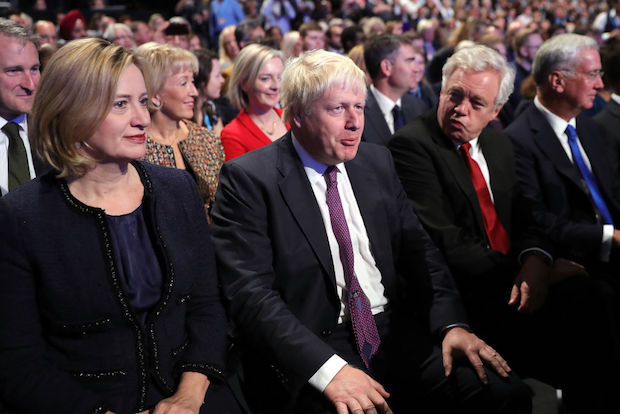The moment Philip May helped his wife from the stage after her conference speech, it became clear that it is only a matter of when, not if, her leadership of the Conservative Party and occupancy of No.10 comes to an end.
What happens next? Who knows, but if you understand the rules, it is just possible a sequence of events has started which will ultimately lead to hundreds of thousands of people participating in a three month election process for a new leader. It might even result in a surprising outcome. In other words, a relatively unknown newer MP, such as Kemi Badenoch (Saffron Walden); or Bim Afolami (Hitchin and Harpenden); or Rishi Sunak (Richmond, Yorks), being chosen.
In the short term, such a contest would mean more uncertainty. It would definitely be a risk. But in the long term, that might be the best outcome. Let me explain.
Given the numerous system failures at the conference which resulted in a prankster getting so close and giving Theresa May what must have been a terrible fright, the letters falling off the set, the disappointing policies, and the conduct of her colleagues, I am sure lots of people found themselves agreeing with Vince Cable, who said he had sympathy for her, as she is surrounded by people who are not only “disloyal, but incompetent.”
A letter is in circulation by Grant Shapps MP, trying to trigger a leadership election. He needs 48 signatures, to succeed. Nobody I have spoken to expects that to happen immediately. But it does seem likely that Mrs May will just resign at some point and be done with it.
In all the excitement, insufficient scrutiny has been given to how exactly a leadership contest might be run in office, for a second time. If the Party is not careful it will run into a legitimacy problem, where the public at large are repelled by their conduct. As one Guardian journalist put it, they look like “drunks fighting in a puddle.”
Here, the Party’s leadership rules, and how they are applied, will be key. They are published here and require a ballot among MPs, followed by the top two candidates going to a ballot of party members.
There may be those who think a College of Cardinals approach to choosing a new leader would be preferable, as it would be quick. That is theoretically possible. As with the choice of Theresa May herself last year, if only one candidate finishes the various ballots of MPs (because other contestants drop put), then there is no need for a ballot of party members.
There are four problems with such an approach this time round. First, there is a good argument that a rushed leadership contest will result in someone unsuitable being chosen, on an uncertain platform with an untested team. That, after all, is what happened in 2016.
Second, there is no obvious front runner. The Boris Johnson balloon is apparently deflating due to his unconvincing tenure as Foreign Secretary and although he would be a candidate, he would only be one among several. If he wants to reflate his balloon, he is going to have to blow hard. (He is, admittedly, good at that).
The third reason is one of legitimacy. We live in populist times. Another process to choose the Conservative leadership and also the Premiership, dominated by white middle aged Establishment men, where only 316 people can vote, is going to lack credibility with the public and be open to merciless criticism from both Labour and the SNP, both of whom have long since switched to a more democratic, one member, one vote, system with, it has to be conceded, some success from their point of view.
The fourth reason is context. Last summer, in the heat of the referendum result, speed in choosing a new leader was of the essence. But now, with time for the Brexit negotiations having been bought by the acceptance of the need for a transition period, the situation is less urgent. Instead, what the Party is really focused on is responding to the threat of Jeremy Corbyn and the fear that if it goes on stumbling around like this, Mr Corbyn will be Prime Minister, possibly quite soon.
If we accept that the rank and file of party members should have the right to vote, this creates a new set of issues.
The first is time. Running a popular vote will require some organisation and the process would have to be presided over by the same people who cannot ensure letters are stuck up properly on a conference set. Hustings will have to be organised, venues booked, television, social and digital media organised. The untidy membership list (actually multiple lists), would have to be tidied up and checked. The duration is at the discretion of the 1922 Committee, but the customary period is at least 12 weeks. During that time, Mrs May would have to stay in office and continue with the Brexit negotiations. Is that credible?
The second issue is participation. Under the rules, in order to vote, you must have been a fully paid up member of the Conservative Party for 3 months “from the time of call for nominations by the chairman of 1922 Committee”. Nobody seems to know for sure how many of these there are, but a recent report by the Bow Group think tank claims that in the last four years the number of members has declined by 50,000 to 100,000 and their average age skyrocketed by 10 years to 72.
Here again, we would run into a legitimacy problem. Having taken the decision to widen the leadership electorate, it would be very difficult to keep the list closed to such a narrow, unrepresentative demographic, especially as the great fault line in British politics is suddenly generational.
If you accept this line of thinking, then a credible leadership election could only be run if it was signalled in advance and the membership list temporarily kept open to allow a few of the the other 46m members of the UK electorate to join, if they wanted to. One might, for instance, say the eligible membership list would stay open for two weeks or so. The average age of the electorate might even come down.
Yet this in turn is not simple. It could potentially trigger a Momentum-style stampede for membership. Applicants would all have to be verified and their cheques cashed. It would also open up the whole contest in unpredictable ways. A mini re-run of the referendum could occur, with Remain and Leave candidates clashing raucously for domination. I cannot pretend to look forward to another such event but at least the Conservative party would have revitalised its membership.
That said, the cat is out of the bag when it comes to a more populist approach to politics. I don’t see how the Conservative Party can run a legitimate leadership election without opening it up to wide participation. But if it is going to take that risk then it would be a great service to the country if Mrs May could use her remaining time in office to prepare the Party and the country for such a contest, especially the logistics. Apart from anything else, such preparation would buy her time and rehabilitate her reputation. Anyone with any humanity or common sense should support her during a transition period.
What would the outcome be? Boris Johnson? Amber Rudd? David Davis? Maybe. The collective conduct of Cabinet has been so depressing I cannot help feeling incumbency will not be an advantage. All really divisive political battles, Lancastrians vs Yorkists, Roundheads vs Cavaliers, Hanoverians vs Stuarts, have in the past been solved by a new generation and it is just possible the winner would be from among the young MPs who none of us know well. In other words, a post-referendum candidate who can unite both Leave and Remain and move on from the current brouhaha. Here is hoping.






Comments